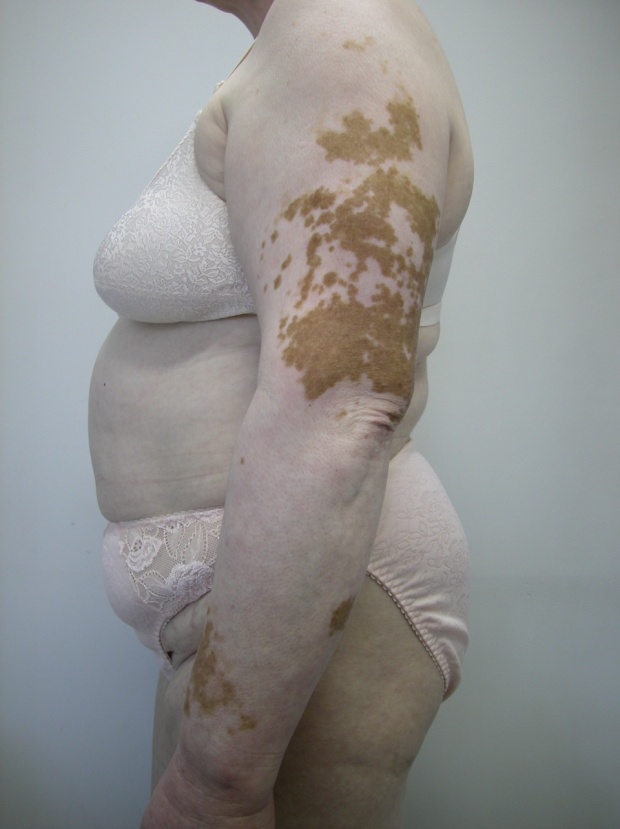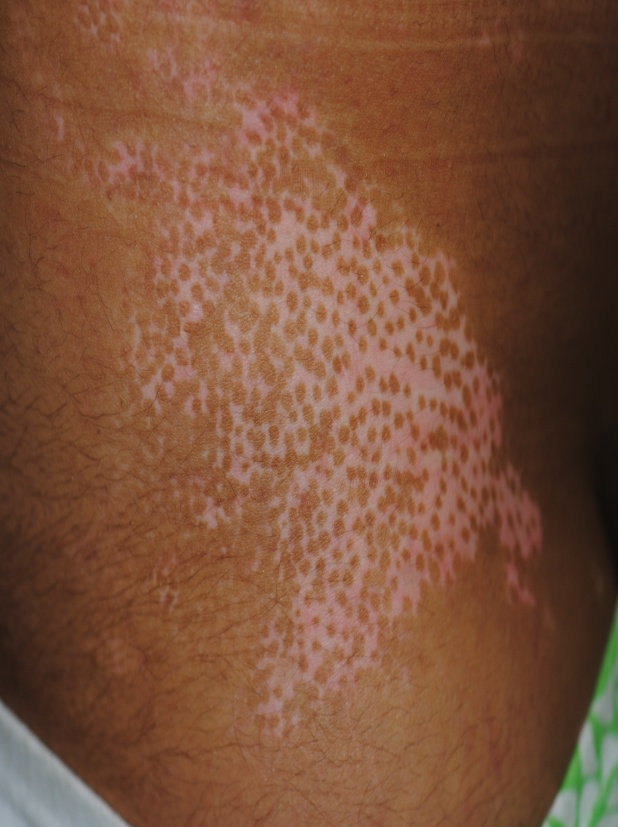Last updated: April 2024
What is vitiligo?
Vitiligo is a relatively common condition in which the skin is unable to produce pigment. Pigment forming cells (melanocytes) are destroyed and the skin becomes white.
Who gets vitiligo?
Vitiligo affects up to 2% of the global population. 1 Its prevalence is relatively consistent between all races but appears to be less common in the Han Chinese population and more common in India.
Both men and women appear to be equally affected and it can occur at any age. A family history is present in 10-36% of cases. 2
What causes vitiligo?
The cause of vitiligo is unknown. It is most likely an autoimmune condition where the body’s immune system attacks its own tissues. In vitiligo, pigment forming cells are targeted.
In individuals who are predisposed to developing the condition, injury to the skin, emotional factors and stress may aggravate the condition.
What does vitiligo look like?
Vitiligo appears as white areas with sharp edges on the skin usually without any preceding inflammation occurring in the affected skin.
Vitiligo can develop in areas of skin injury such as a cut or burn (including sunburn or an abrasion). The condition may be seen under the arms, in the groin, or between the buttocks where one skin surface rubs against another.
White hairs can occur in the scalp, eyelashes, eyebrows and beard.
Eye involvement can also occur.
White areas of skin commonly start to appear in an individual’s twenties and thirties but for some individuals these may first appear in childhood or later in adult life. The condition can get worse over time but the rate at which this happens varies from individual to individual.
The psychological impact of vitiligo can be significant. The cosmetic disfigurement may cause emotional trauma.

Figure 1. Extensive vitiligo – image reproduced with permission of Dr Richard Wittal

Figure 2. Follicular repigmentation with NB-UVB phototherapy – image reproduced with permission of Dr Richard Wittal
How is vitiligo diagnosed?
The diagnosis of vitiligo is based on clinical examination.
Blood investigations are performed to exclude the presence of thyroid disease, diabetes and pernicious anaemia.
How is vitiligo treated?
Treatment options will vary depending on the individual and their needs.
Fair skinned individuals may decide not to be treated at all as the contrast between the white areas and the natural skin colour may not be obvious.
The treatment of vitiligo is frequently prolonged, and progress can be slow. Complete re-pigmentation is not always achieved.
Psychological support plays an integral part in the treatment of individuals with vitiligo.
Some specific treatments may include: 4
- Cosmetic camouflage of the white area.
- Applying treatments that reduce the inflammation and encourage neighbouring cells to produce more pigment, such as:
- Topical cortisone creams or ointments
- Light therapy with narrow band UVB phototherapy
- Photosensitising psoralen drugs made up as creams to the white areas followed by careful sunlight exposure or UVA phototherapy
- Tacrolimus
- Pimecrolimus
- Calcipotriol
- Active repigmentation with surgical treatments.
- Depigmentation, such as monobenzyl ether of hydroquinone destroy the remaining pigment cells.
What is the likely outcome of vitiligo?
The outcome can vary widely with some individuals experiencing stable or slow progression with limited spread over time. In others it may progress more rapidly leading to widespread depigmentation. Various factors such as the rate of progression and response to treatment will affect the outcome.
Earlier treatment can improve outcomes.
- 17755 Global survey investigating the prevalence of vitiligo and vitiligo signs among adults in Europe, Japan, and the United States. Harris, J. E., Ezzedine, K., Bibeau, K., Pandya, A. et al. Journal of the American Academy of Dermatology, Volume 83, Issue 6, AB198
- Karelson M, Silm H, Salum T, Kõks S, Kingo K. Differences between familial and sporadic cases of vitiligo. J Eur Acad Dermatol Venereol. 2012 Jul;26(7):915-8. doi: 10.1111/j.1468-3083.2011.04131.x. Epub 2011 May 31. PMID: 21623928.
- Daniel BS, Wittal R. Vitiligo Treatment Update. Australasian Journal of Dermatology(2015) 56, 85-92.
| Dr Richard Wittal | April 2024 |
| Dr Richard Wittal | August 2014 |
Disclaimer
2019 © Australasian College of Dermatologists.
You may use for personal use only. Please refer to our disclaimer.